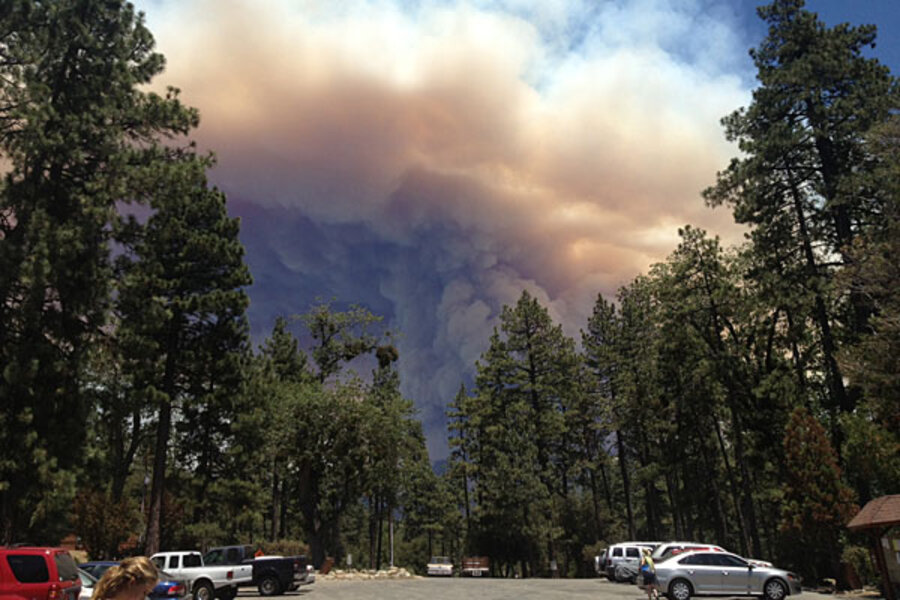In California's Mountain fire, lessons of Yarnell tragedy are everywhere
Loading...
| Los Angeles
As thousands of residents exit their homes in California's San Jacinto Mountains, the so-called Mountain fire is raising questions about whether firefighters should be taking greater precautions after last month's Yarnell fire killed 19 firefighters in Arizona.
The concerns are particularly acute because the Mountain fire "is cooking away in some of the more treacherous terrain in the US – steep, rugged, inaccessible, indefensible," says Char Miller, a professor of environmental analysis and firefighting expert at Pomona College in Claremont, Calif.
According to interviews with fire officials and fire experts, the operative phrase post-Yarnell seems to be, “err on the side of caution.” It’s not so much that tactics or procedures have changed – the report on Yarnell Hill is not yet complete – but that there is a heightened sense of the need to follow existing and time-tested procedures to the last detail.
As of Thursday morning, the Mountain fire had split in two directions. The situation of a fast moving fire line with 40- to 60-foot flames proved too much for nearly 3,000 firefighters, and authorities called for the evacuation of 6,000 residents and visitors in Idyllwild, Fern Valley, and nearby wilderness regions including Mount San Jacinto State Park. The Forest Service says about 2,200 homes and 4,100 residences including hotels, condominiums, and cabins were evacuated.
As of 6:00 a.m. Pacific time Thursday, the fire had consumed close to 20,000 acres and was only 15 percent contained.
AccuWeather.com meteorologists expect winds to remain relatively light from the west and northwest through the end of the week. “However, local effects produced by the terrain and the fire itself can continue to cause the blaze to spread rapidly,” says an AccuWeather.com release.
Temperatures are forecast to peak near 100 degrees with low humidity through Saturday.
For now, firefighters are returning to the basics. A 1957 task force assessed the worst fires from 1937-1956 and came up with 10 Standard Firefighting Orders and 18 Watchout Situations that can be distilled to a four-letter acronym: LCES, for “Lookout,” “Communication,” “Escape Routes,” and “Safety Zone.”
“Safety is always our first responsibility and goal – both for the public and firefighters, so that will not change,” says Mike Ferris, a spokesman for the US Forest Service.
But he and others say that lessons from Yarnell need to be translated into action not just by firefighters, but by homeowners.
“The owners of these properties and communities need to create a defensible space, and if they haven’t done that, they have not aided the firefighters at all, but made the situation worse,” says Mr. Ferris.
Creating defensible space includes removing brush, using fire-retardant roofs and siding, installing attic vents that don’t create unnecessary indrafts for burning embers, and avoiding wood for porches and trash enclosures.
But it's inevitable that Yarnell will have an effect on firefighting – at least in the near term, says Professor Miller of Pomona College. The Mountain fire and all the other fires currently burning the West will be fought much more cautiously.
“That’s from the bottom to the top. Crews will take fewer risks, and they will be asked to take fewer risks. Safety first is always the No. 1 goal, but now everyone on the fire lines are being hyper conscious,” Miller says. “This may be especially true of fires like the Mountain blaze.... The strategy will be to encourage the fire to move away from structures as is possible via water and retardant drops; there will be no frontal assaults.”
In some ways, firefighters don't need to wait for a report to internalize the lessons of Yarnell, says Don Smurthwaite, a spokesman for Bureau of Land Management.
“Whenever there is a serious injury or fatality on a fire, it serves as a somber reminder to firefighters everywhere that their profession is risky by nature,” says Smurthwaite. "In the wake of such tragedies, all firefighters seem to increase their situational awareness and take steps to mitigate risk.”
“What happened at Yarnell Hill will have reverberations among firefighters for years to come,” he adds.
When the investigation is concluded, he says, there may be findings and recommendations that affect some aspect of wildland firefighting. “But it's too early to say what, if any, of those recommendations are. That's part of the investigation team's responsibilities, and any followup that comes after.”
According to meteorologist Ken Clark of Accuweather.com: “Humidity levels are likely to increase substantially over the weekend and could allow spotty pop-up thunderstorms.”
“The higher humidity and any rainfall would greatly assist firefighting efforts,” says a release from Accuweather.com. “However, while some of the storms can bring isolated rainfall, most storms will bring the risk of igniting new blazes due to lightning strikes with little or no rain.”







